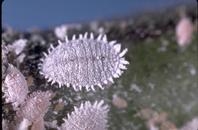Advice for the Home Gardener from the Help Desk of the
UC Master Gardener Program of Contra Costa County
Client's Request: We have been having an issue with our Ficus benjamina for several months. It has been getting increasingly worse. It has mealy bugs. They are on the leaves and branches.

MGCC Help Desk Response: Thank you for contacting the UC Master Gardener Program Help Desk with your question about treating mealybugs on your Ficus benjamina. We will answer the question assuming you've already been given a correct positive identification of mealybug. If you are not 100% sure what the insect is, please consider sending us a close up photo or bringing in a sample for us to use for a positive ID.
As you may already be aware, mealybugs are small, pale insects, related to scales. They are about ? to ¼ inch long and move very sluggishly. The adult females cover themselves and their eggs with a white, waxy material, making them look cottony. Mealybugs are most commonly found on the lower surfaces of leaves and in leaf ails (where the leaf attaches to the stem). They suck plant sap, causing stunted and distorted growth and sometimes plant death.
Mealybugs are difficult to control with insecticides because they have a waxy coat that protects them. On houseplants, (as you have already been guided to try), insecticidal soap, narrow-range oil, or a forceful stream of water can be applied to reduce exposed populations. You can also dip a cotton swab in rubbing alcohol and place it directly onto individual mealybugs to kill them.

Here are links to more information and treatment recommendations (including insecticide options) for mealybug:
http://www.ipm.ucdavis.edu/PMG/GARDEN/PLANTS/INVERT/mealybugs.html
http://ipm.ucanr.edu/PMG/PESTNOTES/pn74174.html
http://ipm.ucanr.edu/PMG/GARDEN/PLANTS/ficus.html
Care of Houseplants
The best way to control insects and related pests on houseplants such as your Ficus benjamina is through prevention, as it is almost always easier to prevent a pest infestation than to eliminate one. There are several precautions that you can take which will decrease the chances of having to deal with a pest infestation of your houseplants:
- Provide a plant with the growing conditions that it needs so that it is more likely to grow vigorously. Stressed plants tend to be more susceptible to pests.
-
Before buying or bringing a plant indoors, always check it and its container for signs of pests. (We have found mealybugs on many plants for sale in various stores so buyer beware!)
-
Isolate new plants from plants already in the home for six weeks to ensure that any pest brought in will be less likely to spread.
-
While plants are isolated, carefully examine them for signs of pests or damage on a regular basis of about once a week. Pay particular attention to the undersides of leaves where pests are most often found. Infestations are often much easier to control if caught early.
-
When repotting a plant, use commercially prepared potting soil rather than soil from outdoors, which can be a source of pests.
- Washing smooth-leaved plants every two to three weeks discourages pest infestations and also improves the appearance of foliage. Small plants can be inverted and swished in a bucket of tepid (lukewarm) water. To prevent loss of soil, cover it with aluminum foil or plastic wrap. Large plants can be hosed down gently, or upper and lower surfaces of leaves can be wiped with a soft, wet cloth. Large plants can also be rinsed in a tepid shower.
Good luck with your tree! We wish we could offer happier news. Please let us know if you have additional questions.
Help Desk of the UC Master Gardener Program of Contra Costa County (SLH)
Note: The UC Master Gardeners Program of Contra Costa's Help Desk is available year-round to answer our gardening questions. Except for a few holidays, we're open every week, Monday through Thursday for walk-ins from 9:00 am to Noon at 75 Santa Barbara Road, 2d Floor, Pleasant Hill, CA 94523, although we will be moving this spring. We will notify you if/when that occurs. We can also be reached via telephone: (925)646-6586, email: ccmg@ucanr.edu, or on the web at http://ccmg.ucanr.edu/Ask_Us/ MGCC Blogs can be found at http://ccmg.ucanr.edu/HortCoCo/ You can also subscribe to the Blog (//ucanr.edu/blogs/CCMGBlog/)
